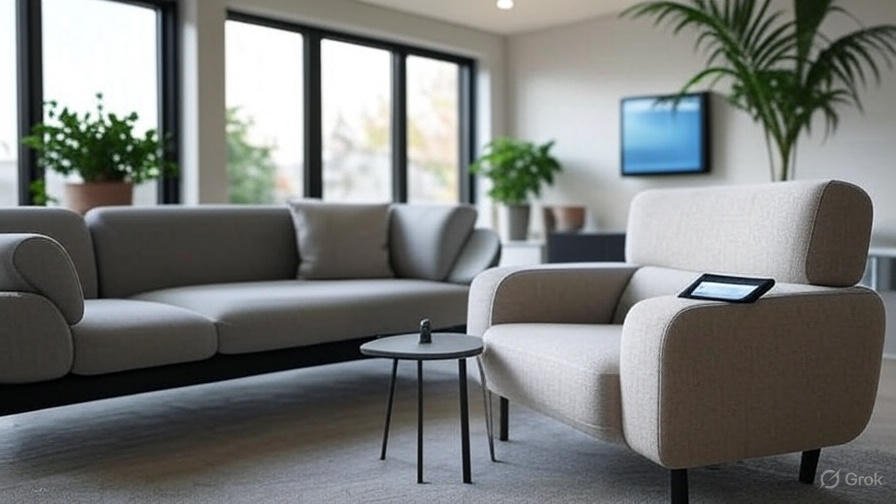The Furniture industry is undergoing a transformative shift, blending cutting-edge technology, sustainable practices, and bold design aesthetics to redefine how we furnish our homes. From eco-conscious materials to smart furniture that adapts to our lifestyles, 2025 is proving to be a pivotal year for home design. This article explores the latest trends and innovations shaping the furniture market, offering insights into how these developments are influencing consumer choices and the future of interior spaces.
Sustainability Takes Center Stage
Environmental consciousness has become a driving force in furniture design. Consumers are increasingly prioritizing pieces that align with their values, pushing manufacturers to adopt sustainable practices. Reclaimed wood, recycled plastics, and biodegradable materials are now commonplace in high-end and affordable furniture lines alike. Companies like EcoFurn and Green Living Designs are leading the charge, offering collections made from responsibly sourced materials that minimize environmental impact.
In 2025, modular furniture has gained traction as a sustainable choice. These versatile pieces allow consumers to reconfigure their setups as needs change, reducing the need for frequent replacements. For instance, brands like ModuForm have introduced modular sofas and shelving units that can be easily disassembled and repurposed, extending the lifecycle of each piece. This trend not only reduces waste but also appeals to younger generations seeking adaptable solutions for smaller living spaces.
Smart Furniture: Technology Meets Comfort
The integration of technology into furniture is no longer a futuristic concept but a reality shaping modern homes. Smart furniture, equipped with features like wireless charging, built-in speakers, and adjustable settings, is transforming how we interact with our living spaces. For example, companies like SmartSpace have unveiled coffee tables with embedded touchscreens that control lighting, temperature, and even home entertainment systems.
One standout innovation is the rise of ergonomic furniture designed to enhance health and productivity. Adjustable standing desks, such as those from ErgoTech, now come with sensors that monitor posture and suggest position changes throughout the day. These advancements cater to the growing number of remote workers who prioritize comfort during long work hours. Additionally, smart beds with sleep-tracking capabilities are gaining popularity, helping users optimize their rest by analyzing sleep patterns and adjusting mattress firmness accordingly.
Minimalism Meets Maximalism
Design aesthetics in 2025 are striking a balance between minimalism and maximalism, offering consumers the freedom to express their individuality. Minimalist furniture, characterized by clean lines and neutral tones, remains a staple for those seeking simplicity and functionality. Brands like Nordik are capitalizing on this trend with sleek, Scandinavian-inspired designs that emphasize form and function.
Conversely, maximalism is making a bold comeback, with vibrant colors, intricate patterns, and eclectic combinations taking center stage. Designers are encouraging homeowners to mix textures and styles, creating spaces that feel personal and curated. For instance, statement pieces like velvet armchairs in jewel tones or hand-carved wooden tables are becoming focal points in living rooms. This trend reflects a broader cultural shift toward embracing individuality and rejecting one-size-fits-all design.
The Rise of Multifunctional Furniture
As urban living spaces shrink, multifunctional furniture is becoming a necessity. Pieces that serve multiple purposes—such as sofa beds, extendable dining tables, and storage-integrated ottomans—are in high demand. Companies like SpaceSaver have reported a surge in sales of convertible furniture designed for compact apartments. These pieces allow residents to maximize space without sacrificing style or comfort.
One notable example is the growing popularity of wall beds, also known as Murphy beds, which fold into the wall when not in use. Modern iterations of these beds, offered by brands like Transforma, feature sleek designs and easy-to-use mechanisms, making them a stylish solution for small homes. This trend underscores the industry’s focus on creating furniture that adapts to the evolving needs of urban dwellers.
Global Influences and Artisanal Craftsmanship
Furniture design in 2025 is drawing inspiration from global cultures, blending traditional craftsmanship with contemporary aesthetics. Artisanal pieces, such as handwoven rattan chairs from Southeast Asia or intricately carved wooden cabinets from Morocco, are gaining popularity among consumers seeking unique, story-driven designs. These pieces add warmth and character to modern interiors, appealing to those who value authenticity and cultural heritage.
At the same time, the resurgence of local craftsmanship is empowering small-scale artisans. Platforms like CraftConnect are making it easier for consumers to discover and purchase handmade furniture directly from makers, fostering a connection between creators and buyers. This movement not only supports local economies but also ensures that traditional techniques are preserved in an increasingly mass-produced market.
Challenges and Opportunities in the Industry
While the furniture industry is thriving, it faces challenges such as supply chain disruptions and rising material costs. The lingering effects of global economic fluctuations have prompted manufacturers to explore innovative solutions, such as 3D printing for furniture production. This technology allows for faster prototyping and customization, reducing reliance on traditional supply chains. Companies like PrintFurn are experimenting with 3D-printed chairs and tables, offering consumers affordable, bespoke options.
Another challenge is balancing affordability with sustainability. While eco-friendly materials are in demand, they often come with a higher price tag. To address this, some brands are partnering with nonprofit organizations to subsidize costs, making sustainable furniture more accessible to a broader audience. These efforts reflect the industry’s commitment to inclusivity and environmental responsibility.
Looking Ahead: The Future of Furniture
As we move further into 2025, the furniture industry shows no signs of slowing down. Emerging trends, such as the use of augmented reality (AR) to visualize furniture in homes before purchase, are enhancing the shopping experience. Retailers like HomeVision are rolling out AR apps that allow customers to see how a sofa or dining table fits in their space, reducing returns and increasing satisfaction.
Additionally, the focus on circular design—creating furniture that can be recycled or repurposed at the end of its life—is gaining momentum. This approach aligns with the broader push toward a circular economy, where waste is minimized, and resources are reused. Industry leaders predict that circular design will become a standard in the coming years, further solidifying the furniture sector’s role in sustainable innovation.
Conclusion
The furniture industry in 2025 is a dynamic blend of innovation, sustainability, and cultural expression, redefining how we interact with our living spaces. From smart furniture that enhances convenience to eco-friendly designs that prioritize the planet, these advancements reflect a broader shift toward thoughtful consumption and personalized home environments. As technology continues to evolve and global influences inspire new aesthetics, the industry is poised to meet the diverse needs of consumers while addressing pressing environmental challenges. For more insights into innovative furniture designs, explore offerings from leading retailers like Furniture. The future of furniture is not just about furnishing homes—it’s about creating spaces that are sustainable, functional, and deeply reflective of individual lifestyles. With these trends leading the way, the furniture market is set to inspire and innovate for years to come.




